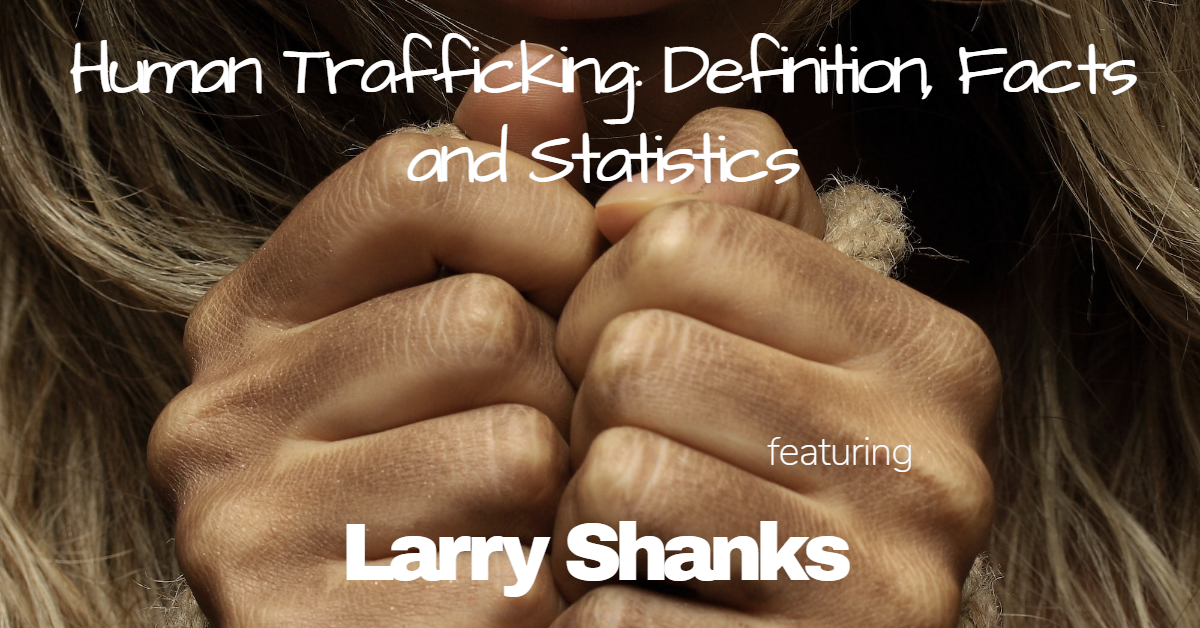Human Trafficking: Definition, Facts and Statistics

What comes to your mind when you think about human trafficking? You probably think it happens in some developing countries. What if I told you, it is happening in your backyard right here in Durham. I have lived in Durham Region for the last 15 years. It is the nuclear capital of Canada. A few minutes east of me is the GM plant. A few minutes south of me is Gerdau Ameristeel. As I drive west, a whole bunch of horse farms, provide meat to the best restaurants in Europe. As I drive north it is a cottage country. I am surrounded by million-dollar homes and the grass is well taken care of and the fences are white.
I interview Larry Shanks, executive director of SafeHope Homes, as he dedicates his life in becoming a game-changer in the lives of women being trafficked.
Human Trafficking Facts
The human trafficking facts as per Durham Region Human Trafficking Coalition are:
- Sex traffickers often control every aspect of the person’s life: when they eat and sleep, what they wear, who they talk to, etc.
- Most often, sex traffickers purposely develop a bond with the person they are trafficking, in order to manipulate them and make them believe they are better off staying than leaving. For this and other reasons, the trafficked person may fear and resist police intervention.
- It can be very difficult for a survivor to leave a trafficking situation. It can take several attempts before they are able to find assistance.
- Language like ‘pimping,’ ‘the game’ and ‘life’ are sometimes used when talking about sex trafficking.
- Sex trafficking is different from consensual sex work – in trafficking situations, the trafficker is in control.
- A person can be trafficked anywhere, including in their home community.
- When a person under 18 is advertised for sex, it is a criminal offense – legally no one under the age of 18 years old can consent to engage in sex work.
- People who are being trafficked, as well as people who come into contact with them, may not know or understand that a crime is taking place.
Human Trafficking Statistics
In 2014, there were 206 police-reported violations of human trafficking in Canada, accounting for less than 1% of all police-reported incidents. The majority of victims were female (93%), while the majority of the accused were male (83%). Between 2009 and 2014, 47% of victims of police-reported human trafficking were between the ages of 18 and 24, while one-quarter (25%) were under the age of 18. Persons accused of police-reported human trafficking tended to be under the age of 35.
From 2005/2006 to 2013/2014, there were 53 completed adult criminal court cases involving human trafficking, of which the majority resulted in a finding of stayed or withdrawn.
Human Trafficking Definition
Human trafficking involves the recruitment, transportation, harboring and/ or exercising control, direction or influence over the movements of a person in order to exploit that person, typically through sexual exploitation or forced labor. It is often described as a modern form of slavery.
Victims suffer physical or emotional abuse and often live and work in horrific conditions. They may also face fatal consequences if they attempt to escape. This crime represents a consistent and pervasive assault on the fundamental human rights of its victims.
Organized criminal networks, as well as individuals, perpetrate this crime, operating within Canada’s borders and internationally. Traffickers reap large profits while robbing victims of their freedom, dignity and human potential at great cost to the individual and society at large. Traffickers control their victims in various ways such as taking away their identity documents and passports, sexual abuse, threats, intimidation, physical violence, and isolation.
Larry, a pleasure knowing you are for a decade. I wish we could talk about a more encouraging topic than human trafficking. Let’s start by telling me a little about you?
I am a father of three grown sons and grandfather to 7 ages 2-9. I came to faith late in life approximately 10 years ago. I had a long business career at senior levels in the building materials business until the calling (about 4.5 years ago) to become involved in the recovery side of the human trafficking issue in Ontario.
What is SafeHope Home? How did you get involved in it?
SafeHope Home offers long-term (3-7 years) comprehensive recovery programs for trafficked young women who are exiting the sex trade. During this time, they are in our housing and receive counseling, recovery, life skills, job preparedness classes, job shadowing, and on-the-job training.
I gained knowledge of human trafficking while on a mission trip to India. Meeting with trafficked young women in Mahima Homes moved me greatly to prompt me to want to learn more and become involved. After returning home and researching human trafficking in Ontario, I realized the vast prevalence and with a small group, we decided the direction of the need for long-term housing and programs and the initiative began in early 2015.
I always thought human trafficking happens elsewhere. But it is happening in Durham. What is the definition of human trafficking?
Human trafficking in Canada refers to the coercion of others for material gain. This coercion into the sex trade is often based on false relationship manipulation, money, drugs, physical abuse or any combination of these. What awaits them is a life of despair, violence, fear, and degradation.
What are the goals, mission, and vision of SafeHope Home?
SafeHope Home will provide a safe place to live and will work to empower our participants to transition into a healthy lifestyle within the community. Our programs were developed to help young women exit the sex trade and rebuild their lives. A general outline of these programs can be seen on our programs page.
I read in the papers all the time that men are caught trafficking young girls. So how do you find them and help them?
Not Applicable, Durham Regional Police HT unit takes care of that.
What are some of the challenges in running SafeHope Home?
Our challenges are many, the young women are quite raw when they arrive, they believe that they have no value, are worthless. Our first objective is to let them know that they still have the same value that they were born with. We deal with trauma-based issues, anger, and addiction issues. Services that we need to utilize from the social community are limited and when available have long waiting lists and we had to become internally more self-sufficient which brings additional financial burden.
Larry, it has to be painful, challenging, and gut-wrenching to do the work you do. But you are a game-changer. What can I as a father of a 15-year-old do to help my daughter stay away from trafficking and what can we do as a society?
The most important thing to do is build awareness in your children, Durham Regional Police and Victim Services are now educating all grade, 9 students, on this issue.
Durham Regional Police has provided signs that a person may be a trafficking victim:
- Isolation from Family and friends
- Become secretive
- Mood Swings – change in attitude
- New circle of friends
- More than one cell phone
- Change in Style of Dress
- Coming home later than usual
- Binge eating
- Possession of hotel keys – cards
- New tattoos – branding
- Unexplained bruises /cuts
- Stockholm syndrome: protective of new “boyfriend” (or girlfriend)
- Possession of expensive items they cannot afford
Sometimes we can get charity fatigue. What is SROI and how do you measure it?
Social return on investment is based on individual ability, goal achievement and eventually having the ability to live in the community independently. We have been in full operation for only about 15 months so we are in the early stages of recovery but with that said, all of our participants are working on their education and some will soon be moving toward independent living.
Talk to me about a success story that you have helped?
The women in our programs are at varying stages and the fact that they have committed to our recovery program in its self if a huge success. We are sober living and some are pulled away by their addictions. They remain a part of us in our outreach program and the relationship is maintained.
The experience through this outreach of having a young woman call and tell us that she wants to come back is huge; we have found that their dedication to recovery is much stronger.
What motivates you daily to get up and make a difference?
What we do takes a huge commitment and determination, the business was easy in comparison but nowhere near the level of reward. This is a long journey for our participants and can be extremely challenging day to day. When one of our young ladies walk into my office with a smile on her face because of an accomplishment or simply because she is having a good day, that’s what keeps me going. I have overseen several large organizations in my life and always enjoyed my career but nothing compares to what we do at SafeHope Home. Regardless of the ongoing pressure and emotional challenges we face, I absolutely love what I do.

Photo Credits: Anh Nguyen on Unsplash, Thibault Debaene on Unsplash, Photo by Baylee Gramling on Unsplash, Tim Gouw on Unsplash, Alex Sheldon on Unsplash, Alexandru Zdrobău on Unsplash

This is a heartbreaking topic. I was so glad to hear about the work that Larry and the Home are doing, giving hope and purpose to these women. Thanks for sharing the information
Human trafficking is a terrible atrocity and it does not get enough attention. I am thankful for people like Larry who are willing to do the hard work to help victims.
I think the more people are aware of what it actually is, the more people can begin to recognize it if/when they see or suspect something. I have been reading about the increased risk Indigenous women and girls are at for sex trafficking because of a severe lack of reporting on the issue and it’s heartbreaking. Thanks for sharing the info.
This is a real eye opener and so heartbreaking to hear. What wonderful work Larry is doing though.
This really does affect far more people than most believe. Houston has a huge trafficking problem. There are solutions, but I fear that too many people lack interest in prevention and prefer to be reactionary. He is doing such important work. Thank you for sharing his story.
Thank you for raising awareness about this. The signs of trafficking were really interesting to learn about. This is great work!